The grass is white with frost and clothes left out to dry on the line are soaked by sunrise. How did Fall slip from my grasp and winter creep down my throat? As the plants halt their growth and the animals begin to fluff with their winter coats I am struck with a sense of accomplishment at what this year has brought to the homestead.
Summer and Fall were incredibly short but somehow Luke and I were able to wrap up an incredible beekeeping year ending with 34 healthy hives, goats were added to the homestead mix as well as Solar power. With the nice weather being very short it almost left no time to prepare for what is said to be a harsh winter.
So as Winter approaches suddenly, how do I prepare my livestock living off-grid? The first step was to secure shelter. Reduce drafts and moisture by wrapping the rabbit hutches in heavy-duty plastic on the side most exposed to wind. This is also done on the chicken coop and an additional low-cost shelter was added for the goats so they do not have to fight over space out of the rain, hail, and snow.
Goat Pallet Shelter:
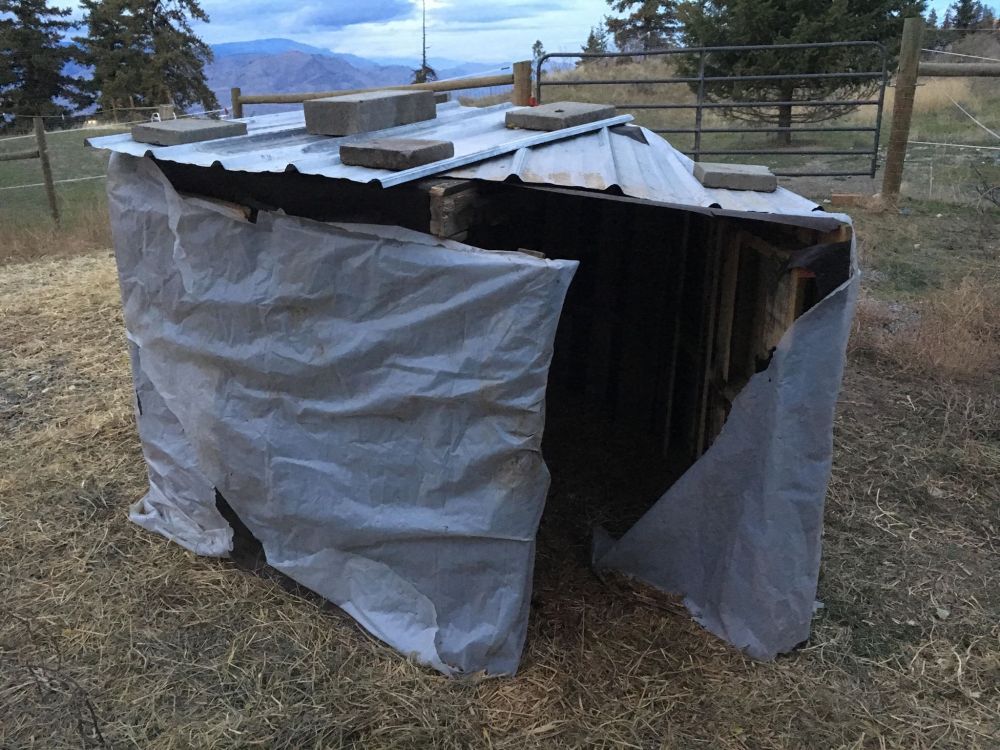
This pallet shelter is easy, cheap and quick to create. Simply grab five pallets, roughly the same size and screw 4 of them together so that there is a small opening. I then covered the pallets in a black moisture barrier that was leftover from an old roofing project. The black moisture barrier is not very strong against goat horns so I then added a plastic sheet over the top of the moisture barrier and stapled it onto the pallets as well. Next, add the last pallet to the top of your wall structure and screw in place as the goats might try to jump onto the shed. Once the roof pallet is in place add a layer of black moisture barrier paper and then metal roofing. My structure is temporary for the season only so I simply placed cement bricks on top instead of screwing the metal to the pallet. ( I will reuse the metal in another project down the road and did not want to add holes to the metal.) I finished the shelter with some fresh straw inside and the goats seem to love this little space to get away from the elements. 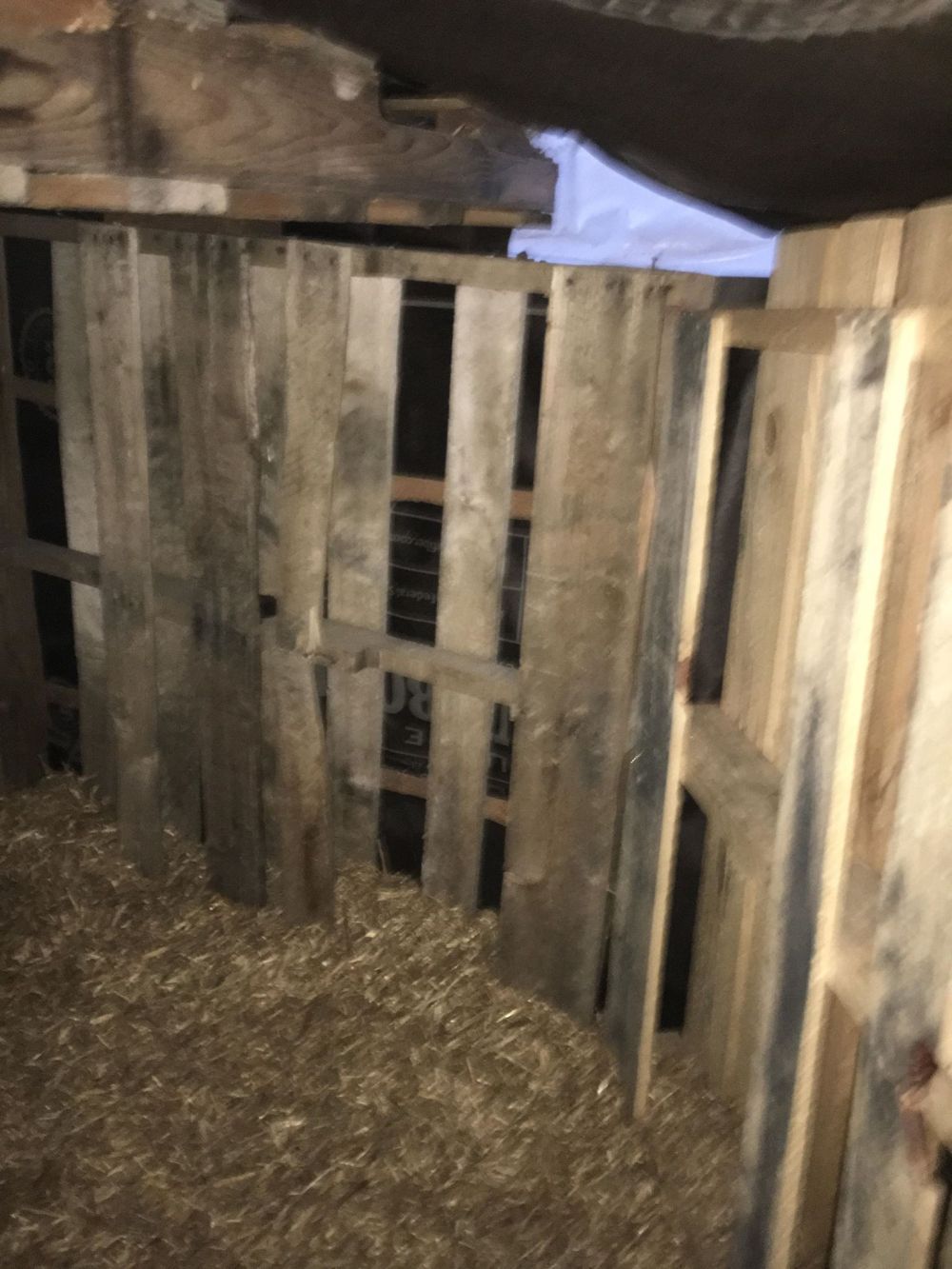
Animal Water in the Winter:
All water troughs and drip line containers are deep cleaned and stored away as they are useless in the winter. The water bottles and black rubber totes are brought out of storage as they are easier to dump and refill. Once Winter is officially here I will begin to change waters out twice a day for all the animals. The rabbit water bottles are rotated out and the frozen bottles are placed by the wood stove to thaw in a bucket until the next rotation. The chickens’ rubber tote is simply tipped upside down and stepped on to break the ice chunks and then refilled with a pitcher. The goats, however, are a bit more tricky as they consume more water than my other smaller critters. To reduce the goat waters from freezing I have built a tire insulator to keep the mass of water from freezing as quickly as the chicken and rabbit waters.
First I went to my local tire store and collect free used tires. You want to find a size that will fit your water containers or be willing to cut out some of the tire sidewalls. Once I had my tires I took them home and bolted them one on top of the other.
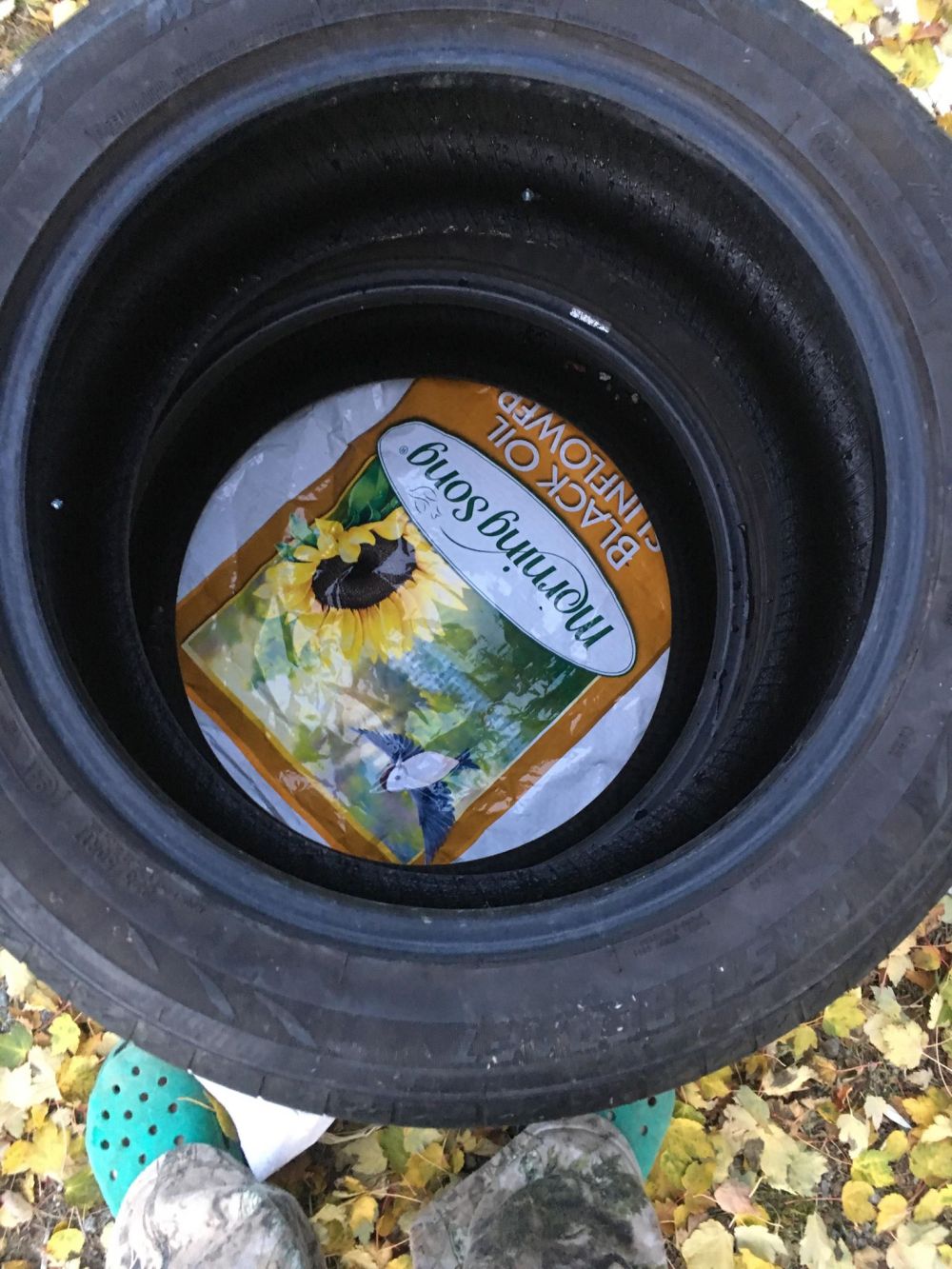
Once the tires were secured to one another I then began to fill the inner walls with spray foam, I placed a used feed bag under the tires to limit the mess. I allowed the first round of spray foam to dry completely before flipping the tires over and filling the second tire. The spray foam will help to insulate the water container and allow it to freeze at a slower rate. You may want to partially bury one of the tires depending on your winter temperatures. I am at a rather high altitude so I will be burying the bottom tire halfway to increase insulation. If you have a sheet of foam insulation laying around I would cut an opening for your bucket and create a sort of lid to increase the insulation properties.
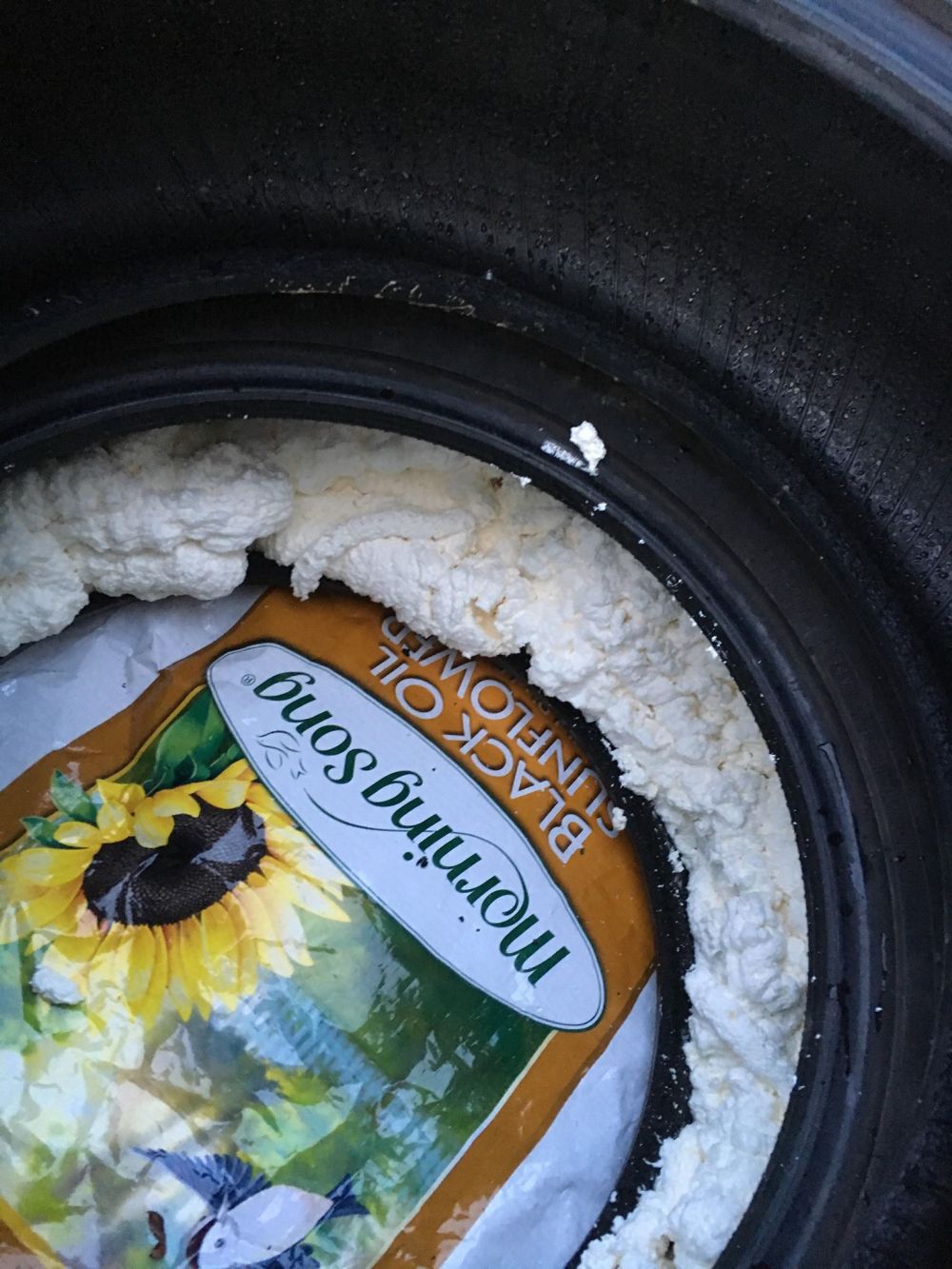
Once the foam is completely dry go ahead and fill in any gaps between the tires you see from the exterior, I used a clear silicone because it was something I already had on hand. Then trim the foam so that your bucket fits snuggly in the tires. Here is the tire waterer before I have nestled it into the ground partially. I would prefer a larger bucket so I am on the hunt for something a little deeper. It would also be better to have a black rubber container versus my green plastic one.
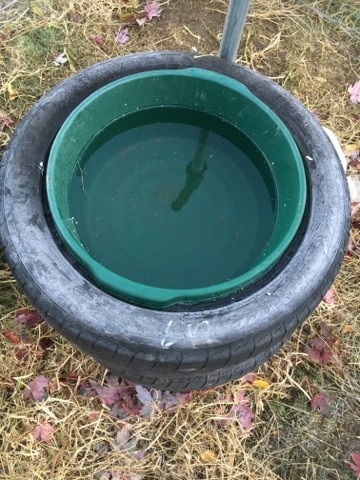
Animal Food Storage:
This time of year is a high traffic time when the pack rats and mice come out to store up any food scraps they can find. In order to deter the small critters from snagging any feed from my animals, I place all feed in metal containers with a tight-fitting lid. Determined rodents will chew through feed bags and plastic containers when the temperatures drop low enough. This metal can is one I use for a majority of my supplements, sunflower seeds and feed. I have yet to have a problem with pests eating the feed out of the storage containers. The chicken feed in the chicken coop is a whole other matter, however. I am still experimenting with how to keep the little mice from squeezing through the chicken wire to munch on the chickens feed while they roost. The pressure feed containers that chickens step on to allow the feed to drop are rather expensive and I am not sure a hanging feeder would stop a mouse from jumping up to eat. So I might just have to bite the bullet and pull their feed at night.
What are some of your winter tricks for keeping your livestock happy and healthy during the coldest, darkest time of year? Please, feel free to share with me your experience so I can learn from you as well!

Really clever ideas! Thank you! I love the tire idea. We live in southern Colorado so I usually just have to break ice in the morning. Throughout winter I just bring out pitchers of water or even the kettle with boiling water to melt the top layer of ice. I sure wish my chickens ate mice! They don’t, so we always get the winter bunch of them in the coop.
LikeLiked by 1 person
Really interesting on off-grid insulation for waterers. We have an plug-in heated waterer that we use for the ducks (it keeps the water just above freezing so it’s super minimal on the electric) – wondering if that could be connected to a solar charger? Oh and we LOVE our metal lidded garbage cans for both duck and chicken feed…and definitely for the chooks take the food away at night (they are currently in a plush barn stall as their chicken tractor showed the risk of taking flight during a recent windstorm!), but it really doesn’t keep mice or other rodents out because even without food access, the critters can crawl anywhere and are looking to nest more than anything, oy! Luckily their time is almost up!
(PS – I put my longtime blog EcoFeminist on hold for a bit after a lot going on at home, and started a new one Beloved Farms that’s purely farm/eco based if you want to check it out!)
LikeLiked by 1 person
Excellent! I will look up the new blog ❤️ I too have been so wrapped up in live before winter that I hardly have time to sit down and write. Right now I don’t have spare change for more solar for the animals waters but hopefully in the future I will! Goals!
LikeLiked by 1 person
Prepping for winter here as well this week. That’s a cool bucket insulating idea, have you had experience with it yet to see how much it helps? What temp has it worked down to?
We have found that using “hot mash” to feed the animals on cold days really helps. We add very hot water to their feed to make a mash (like cream of rice/oatmeal kind of consistency) morning and evening any time it is below 15F. The chickens are easy and love it. Theirs goes into wide shallow feed dishes (or the plastic dishes that go under big plant pots). So there is plenty of space for them all to share.
The goats and sheep are different – some like it and some don’t, although ours are not generally getting grain during the winter months unless they are in milk. When they are not getting grain or don’t like it, we just give them some alfalfa and extra hay to give them extra energy for the cold.
We also add hot water to the LGD’s food and the barn cat food. It seems to give them all a helpful boost on those very cold days.
***We always check any hot mash with a finger before we give it to the animals to make sure it isn’t too hot.***
And when we had rabbits we would refill their water bottles with warmish water instead of cold to encourage drinking and warm them a bit. We had to change out bottles 2-3 times a day on the very cold days because of freezing. Because of that, we always had twice as many water bottles as we needed for cages. So there was a set of them inside in the tub thawing and a set on the cages. Then we would get the ones inside warm and refilled and take them out and switch them for the frozen ones. Made it much easier than bringing in frozen and having to deal with thawing, refilling, and putting back out all at once. Having a handled tote that they all fit in made this a lot easier too.
It definitely takes extra work on those cold days to keep everyone warm and safe.
LikeLiked by 1 person
I too use more bottles than cages so I can put the frozen ones to melt by the wood stove and the thawed ones out on the cage. As for the goat water tire it has been working well, we had temps of 27 last night and all the regular water troughs had a half inch of ice and the tire had no ice at all! Made me very happy! I’ll keep you posted further as winter progresses
LikeLiked by 1 person
We only had sheep, who keep a lot of their insulation with them at all times. They had a shed with fresh hay and in the mornings on the walk to the bus stop one of us would break up the ice on the trough, sometimes 3″ thick, and then on the way home we’d do it again, and follow back down from the house with pails of water.
LikeLiked by 2 people